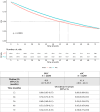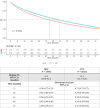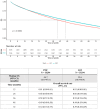Health and Economic Impact of Different Long-Term Oxygen Therapeutic Strategies in Patients with Chronic Respiratory Failure: A French Nationwide Health Claims Database (SNDS) Study
- PMID: 38822956
- PMCID: PMC11282007
- DOI: 10.1007/s41030-024-00259-x
Health and Economic Impact of Different Long-Term Oxygen Therapeutic Strategies in Patients with Chronic Respiratory Failure: A French Nationwide Health Claims Database (SNDS) Study
Erratum in
-
Correction to: Health and Economic Impact of Different Long-Term Oxygen Therapeutic Strategies in Patients with Chronic Respiratory Failure: A French Nationwide Health Claims Database (SNDS) Study.Pulm Ther. 2024 Jun;10(2):263-265. doi: 10.1007/s41030-024-00266-y. Pulm Ther. 2024. PMID: 39017857 Free PMC article. No abstract available.
Abstract
Introduction: Long-term oxygen therapy (LTOT) is reported to improve survival in patients with chronic respiratory failure. We aimed to describe effectiveness, burden, and cost of illness of patients treated with portable oxygen concentrators (POC) compared to other LTOT options.
Methods: This retrospective comparative analysis included adult patients with chronic respiratory insufficiency and failure (CRF) upon a first delivery of LTOT between 2014 and 2019 and followed until December 2020, based on the French national healthcare database SNDS. Patients using POC, alone or in combination, were compared with patients using stationary concentrators alone (aSC), or compressed tanks (CTC) or liquid oxygen (LO2), matched on the basis of age, gender, comorbidities, and stationary concentrator use.
Results: Among 244,719 LTOT patients (mean age 75 ± 12, 48% women) included, 38% used aSC, 46% mobile oxygen in the form of LO2 (29%) and POC (18%), whereas 9% used CTC. The risk of death over the 72-month follow-up was estimated to be 13%, 15%, and 12% lower for patients in the POC group compared to aSC, CTC, and LO2, respectively. In the POC group yearly mean total costs per patient were 5% higher and 4% lower compared to aSC and CTC groups, respectively, and comparable in the LO2 group. The incremental cost-effectiveness ratio (ICER) of POC was €8895, €6288, and €13,152 per year of life gained compared to aSC, CTC, and LO2, respectively.
Conclusion: Within the POC group, we detected an association between higher mobility (POCs autonomy higher than 5 h), improved survival, lower costs, and ICER - €6 238, compared to lower mobility POCs users.
Keywords: Chronic obstructive pulmonary disease; Chronic respiratory failure; Cost-effectiveness; Long-term oxygen therapy; Portable oxygen concentrator; SNDS.
© 2024. The Author(s).
Conflict of interest statement
The study was sponsored and funded by Inogen Inc., which has neither participated in the conduct of the study nor in the analysis of the data. At the time of study conduct and manuscript submission, Dr. Stanislav Glezer was an employee at Inogen Inc. and a shareholder of Inogen Inc. He worked as the Executive Vice President, R&D and Chief Medical Officer. Dr. Abhijith Pg is an employee at Inogen Inc. and a shareholder of Inogen Inc. He works as Director Medical Affairs. Dr. Gregoire Mercier served as French medical expert. He works as the Head of Data Science at the Montpellier University Hospital and the Desbrest Institute of Epidemiology and Public Health (IDESP), Montpellier, France. Dr. Jean-Marc Coursier served as French medical expert. He works as a pneumologist at the Antony private hospital, Antony, France. Nicoleta Petrica served as consultant data scientist, Alira Health, Paris, France. Maria Pini served as medical writer, Alira Health, Paris, France.
Figures










References
-
- Disease GIfCOL: GOLD 2023 - Global Strategy for Prevention, Diagnosis and Management of COPD: 2023 Report. 2023. https://goldcopd.org/2023-gold-report-2/
-
- Mirabile VS, Shebl E, Sankari A, Burns B. Respiratory failure. In: StatPearls. Treasure Island: StatPearls; 2023. - PubMed
-
- Duck A. Cost-effectiveness and efficacy in long-term oxygen therapy. Nurs Times. 2006;102:46–50. - PubMed
LinkOut - more resources
Full Text Sources
Miscellaneous

